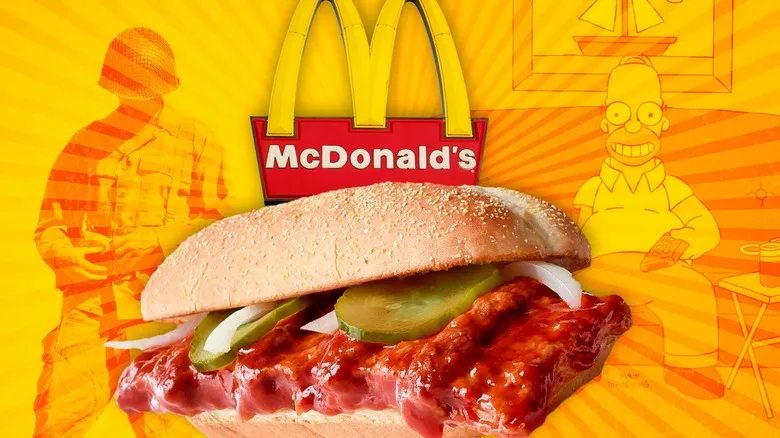The McRib debuted in 1981
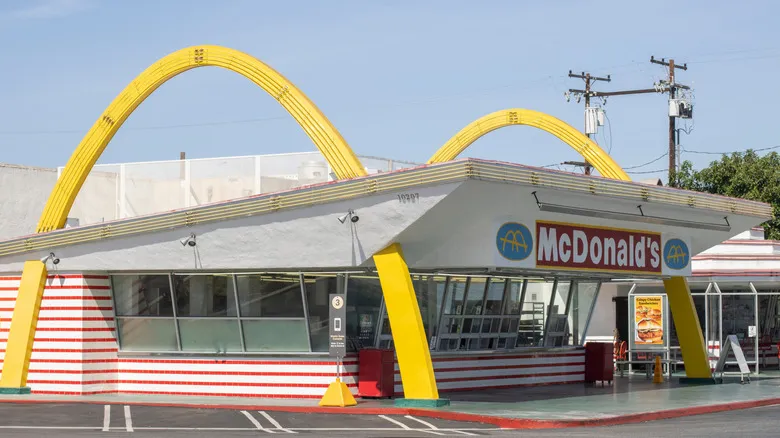
Before introducing the arguably more beloved Chicken McNugget, René Arend brought the McRib to life in 1981. It was initially tested in Kansas City, Kansas, for a year before making its national debut in 1982. According to Retroist.com, the McRib faced lukewarm reviews at launch, with "McFlop" being a common term among contemporary journalists. It stayed on the menu for a few years until McDonald's opted to remove it in 1985.
Just a few years later, however, McDonald's was thriving. In 1989, the company reported earnings of $727 million, the same year it sold its 75 billionth burger to one of its 22 million daily customers. McDonald's promoted the McRib as a "barbecue in a bun," priced at just $1.69. While it wasn't popular enough to become a permanent menu item, it did inspire a new generation of fast food enthusiasts, including Allison Robicelli from The Takeout.
The U.S. Army helped bring the McRib to life
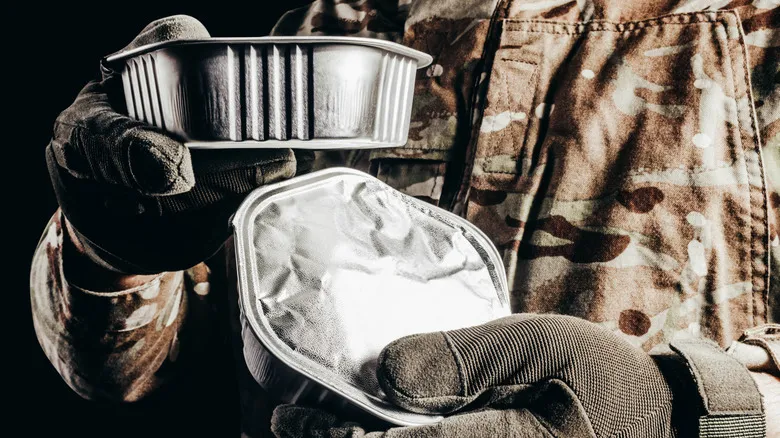
One of the most recognizable features of the McRib is the distinctive shape of its meat. It has the basic form of a burger, allowing it to fit perfectly on the slightly elongated hoagie roll, but it also boasts ribbed indentations that resemble the look of barbecued baby back ribs. While many customers have speculated about the design of the McRib patty, it is actually the product of technology developed by the U.S. Army.
In the 1960s, the Army sought ways to reduce food production costs. With meat preparation and packaging posing a significant financial challenge, they turned to the Natick Army Labs in Massachusetts. Roger Mandigo, a meat scientist and professor at the University of Nebraska-Lincoln, developed a method that utilized low-cost meat trimmings combined with sodium and fat. This process allows the final product to be shaped and frozen for distribution — the same technique that gives McDonald's chicken McNuggets their unique forms.
In an interview with NPR, Mandigo acknowledged that McDonald's was responsible for creating the rack of ribs shape. His initial McRib prototype resembled a pork chop, but he noted that McDonald's wanted it to "look like the boneless part of a back rib." Mandigo's innovations in meat processing were so significant that he was inducted into the Meat Industry Hall of Fame in 2010.
McDonald's sold McRib sauce for charity
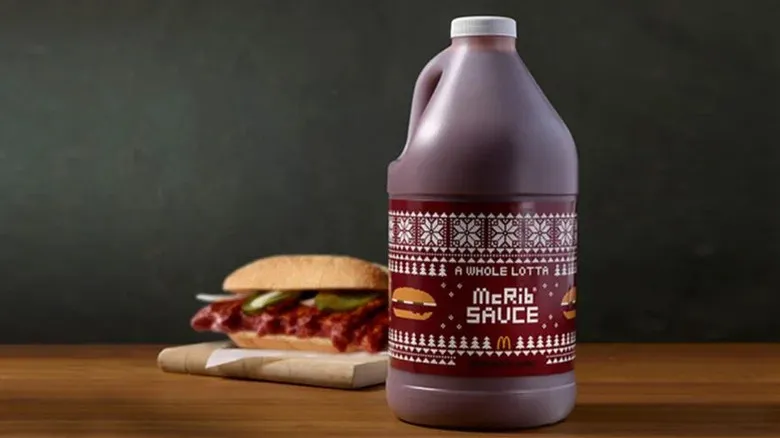
Much emphasis is placed on the visual appeal of the McRib sandwich — from the hoagie bun to the faux-rib shape and onions — but what about the distinctive sauce that defines this barbecue delight? When the McRib made its comeback to McDonald's menus in 2024, the fast-food chain offered half-gallon bottles of McRib sauce for sale. Marketed as "A Whole Lotta McRib Sauce" and priced at $19.99, these jugs of zesty holiday goodness sold out in mere minutes, with all proceeds benefiting the Ronald McDonald House.
While it's unclear if McDonald's will repeat this promotion, devoted fans of the McRib's sweet and tangy flavor can easily recreate this sauce at home. According to Mashed, the top brands to capture that McRib essence are Hunt's Original Barbecue Sauce or Bull's Eye Sweet & Tangy. Home cooks can also whip up a version of the McRib sauce using a simple mix of ketchup, molasses, Worcestershire sauce, brown sugar, apple cider vinegar, onion powder, garlic powder, and a few smoky spices.
The McRib is the subject of a blues song that went viral
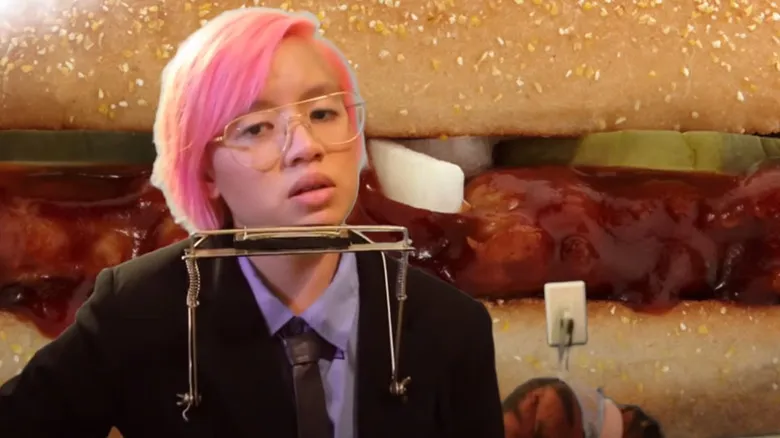
The ultimate measure of a cultural icon lies in its capacity to spark creativity among its supporters. In the case of the McRib, we have Xanthe Pajarillo from Santa Clarita, California. One YouTube commenter even referred to her as the "Bob Dylan of processed BBQ pork." Pajarillo's journey began like that of many a marginalized artist. When her local McDonald's outlets chose not to include the McRib in their 2015 promotion, she took her case to the Santa Clarita city council, seeking to rectify this injustice in the fast food realm.
Her entire appeal can be found on YouTube, but the crux of Pajarillo's argument was that the McRib was a vital component of her family's Thanksgiving tradition. According to her, her family would order a large quantity of chicken McNuggets and McRibs for their holiday feast. Without the McRib, she asserted that her "family's holiday spirit is kind of messed up and broken."
When the city council failed to address this issue, Pajarillo wrote "The McRib Song (McRib Blues)" and showcased it on her YouTube channel. In this heartfelt composition, the pink-haired McRib advocate shares her poignant story through acoustic guitar and harmonica. While the song may not have swayed the local McDonald's franchises, it effectively conveyed the yearning of someone missing out on a limited-time offer. Today, Pajarillo is an emerging filmmaker who documented her experiences as a McRib activist in the short film "We Want McRib."
The McRib was a permanent menu item in the U.S. for 10 years
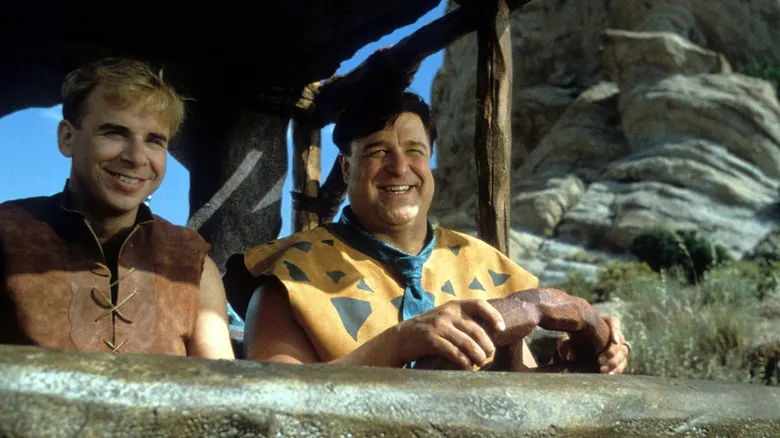
When McDonald's brought back the McRib in 1989, it was introduced as a limited-time addition to the existing burger lineup. However, by 1995, the company decided to make the McRib a permanent fixture on the menu. Its revival in the mid-90s was promoted through a marketing campaign linked to the 1994 Universal Studios film adaptation of "The Flintstones."
The McRib continued to be available at McDonald's until its "farewell tour" in 2005, which provided fans with one last chance to enjoy the sandwich. According to QSR, this farewell tour reintroduced the McRib at select locations nationwide and featured a website with pork trivia and an unsuccessful petition to keep the sandwich permanently on the menu.
When the McRib returned to menus in 2022, McDonald's revived the farewell tour marketing strategy to boost sales ahead of its expected departure. Similar to the 2005 farewell tour, the messaging suggested that the McRib would be leaving for good, even though it was clear it wouldn’t be permanently removed from McDonald's offerings. Since then, the McRib has maintained a regular schedule of appearances as a promotional item on McDonald's menus.
The McRib is still a permanent menu item in Germany and Luxembourg

While many fans of the McRib in the United States bid farewell to the sandwich each year, McDonald's outlets in Germany and Luxembourg are fortunate enough to enjoy it all year round. These two European nations are the only places where the McRib doesn't go on farewell tours, disappearing for an uncertain period. The reasons behind this phenomenon are open to speculation, but it's clear that the McRib was exceptionally well-received in these specific European markets when it first launched. Due to this popularity, McDonald's in Germany and Luxembourg has continued to offer the McRib since its reintroduction in 1989.
One factor contributing to this popularity is likely Germany's rich history of pork production. According to German-meat.org, the country exports over 2.3 million tons of pork to more than 100 countries, making it one of the world's leading pork producers. Given that Germany is also one of Europe's largest pork consumers, it's no surprise that local McDonald's enthusiasts have a fondness for this pork-based creation. The McRib's presence in Luxembourg may be attributed to German pork imports, but it's also worth noting that this small European nation is the birthplace of René Arend, the inventor of the McRib. It's quite poetic to consider that the McRib remains on the McDonald's menu as a tribute to this pioneer of meat processing.
The McRib is a recurring limited-time offer for a reason

As reported by Forbes, McDonald's choice to bring back the McRib as a limited-time offer ticks all the boxes for effective marketing. The secret to the McRib's popularity lies in its exclusivity—it transforms into a special occasion each time it appears on McDonald's menus, generating significant media buzz. Additionally, McDonald's has not labeled the McRib as a seasonal item, which enhances its exclusivity since customers are left guessing when it might return.
The perceived scarcity of the McRib not only boosts sales but also serves as a strategic advantage for McDonald's when it wants to shake up its menu. CNN notes that McDonald's, along with brands like Starbucks, utilizes these limited-time promotions to refresh customer interest. In McDonald's case, it also helps create a positive, hype-driven marketing strategy as a response to a widely reported E. coli outbreak.
There is an online McRib locator

McRib enthusiasts Alan and Kimberly Klein were such devoted fans of the sandwich that they created the McRib Locator, an online platform where users can share tips on where to find a McRib throughout the year. This website not only identifies participating McDonald's locations but also provides an average price, helping users find the best deal on a McRib during its promotional period. The concept allows users across the country to upload the location of a nearby McRib, with the site requesting a receipt for verification.
While the site becomes particularly active during the national McRib promotion, it’s a handy resource to bookmark for when you’re traveling outside your home state or even abroad and suddenly crave McDonald's. Keep in mind that about 95% of McDonald's restaurants are locally owned franchises. While most franchises tend to follow the corporate guidelines, some may choose to diverge from the national strategy if it benefits their local business.
Homer Simpson is a fan ... sort of
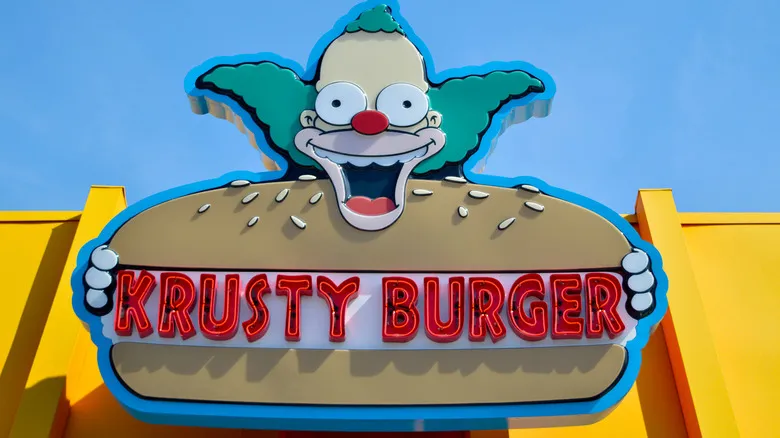
In a 2003 episode of "The Simpsons" titled "I'm Spelling As Fast As I Can," Homer Simpson experiences a taste of McRib mania—though in the fictional town of Springfield, it’s known as the Ribwich and is sold at Krusty Burger. As the story unfolds, a sauce-covered Ribwich mascot entices Homer inside, leading him to become hooked on the promotional item. The episode also pokes fun at the process that gives the McRib its distinctive shape through a Krusty Burger commercial featured during the cold open.
While the show doesn’t hold back in its satire of the McRib, the mere presence of a similar sandwich highlights its cultural significance. "The Simpsons" has become one of the longest-running television series in American history due to its knack for targeting the most profound aspects of the nation with sharp humor. So, when Homer devours a dozen Ribwiches and drools to the point that the overwhelmed cashier has to request a "drool cleanup," he’s simply demonstrating to McRib enthusiasts that he understands their obsession.
The McRib has developed a substantial cult following

Over the years, the McRib has garnered a dedicated fanbase, as evidenced by its presence on Reddit. In the r/McRibReddit community, users share any news related to the McRib, along with photos, recipes, and tips for preserving the beloved sandwich. One user, known as smellybassist, sought advice on how to stockpile frozen McRib patties. With resources like the McRib Locator and r/McRibReddit, enthusiasts have plenty of tools at their disposal when the McRib inevitably disappears from McDonald's menu.
The McRib's popularity has also inspired various artists to create and sell McRib-themed artwork. The Etsy marketplace features a range of unique crafts inspired by the sandwich. For those who appreciate the McRib's visual appeal, the Open Range McRib piece by OctopusCrime showcases the sandwich in a serene countryside setting. Meanwhile, those looking to incorporate the McRib into their holiday decor can find a McRib-themed ornament from FoodieOrnaments.
From folk songs to "Simpsons" episodes and online McRib locators, it's clear that the McRib has established itself as a true symbol of American fast food culture. Although it took some time to gain traction, the McRib serves as a reminder that it's never too late to reinvent oneself.
Recommended

How Faygo Soda Became A Classic Michigan Drink
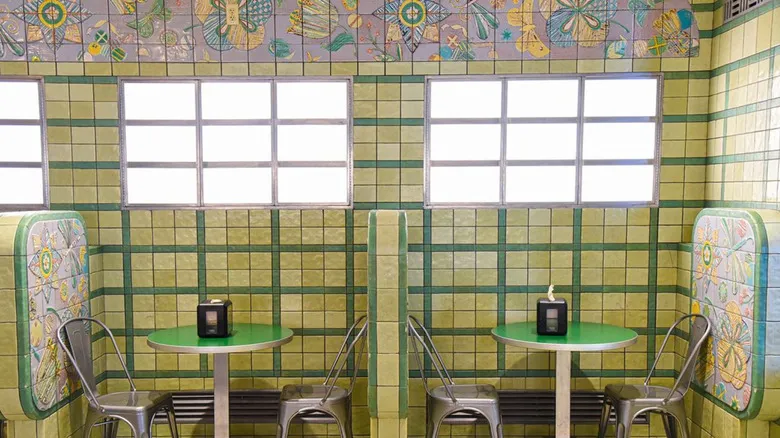
The Ohio Ice Cream Parlor That's An Art Deco Dream

Ever Wonder Why We Eat Three Meals A Day?
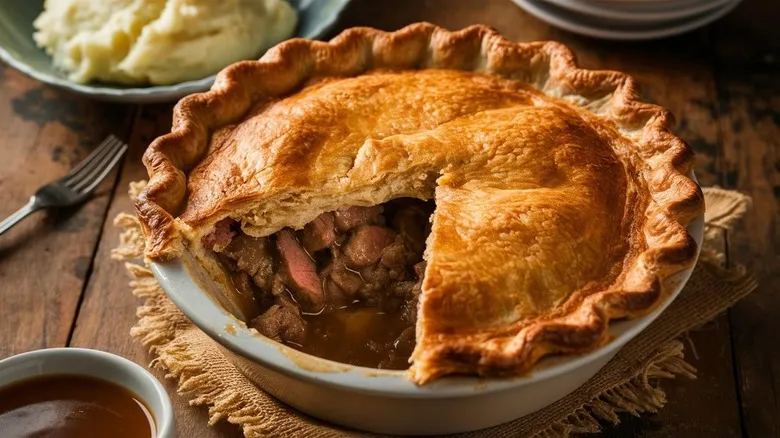
Why A Charles Dickens Novel Is An Important Part Of Steak And Kidney Pie History
Next up

